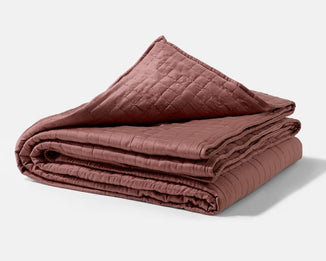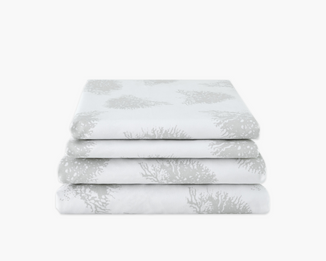
Jul 25, 2022
12 Couple Sleeping Positions and What They Say About Your Relationship

Body language can provide all sorts of subtle hints that shed light on how one person feels about another, especially when it comes to romantic relationships. Everything from mirroring your partner’s movements to holding hands can be telling. But have you ever wondered what your body language might be communicating while you sleep?
As it turns out, how you and your better half curl up in bed can reveal a surprising amount of insight into your relationship. When we fall asleep, our brains essentially “go offline” as we recuperate from the day. Some body language experts believe that the sleeping positions we adopt subconsciously (or consciously) can convey how we feel about a partner. It’s pretty fascinating!
Ahead, we’ll take a deep dive into 12 couple sleeping positions and what they may reveal about your relationship. We’ll also provide tips for getting more shut-eye together — from upgrading your bed to cozying up to a weighted blanket.
Shop Weighted Blankets12 Couple Sleeping Positions and What They Say About Your Relationship
1. The Spoon
Spooning is one of the most easily recognizable couple sleeping positions, and with good reason! Beyond being comfortable and intimate, research suggests that spooning is packed with significant health benefits — like lower blood pressure, reduced stress and better sleep.
Typically, spooning involves two people lying on their sides, facing the same direction. One person acts as the “big spoon,” hugging the backside of the so-called “little spoon.”
New couples, in particular, tend to gravitate towards this oh-so-cozy sleeping position because of its deeply intimate nature. By snoozing in this position, you’re communicating that you trust your partner and feel comfortable in the relationship.

Unfortunately, couples in this sleeping position may be more likely to overheat due to their combined body temperatures. To get through the night without sweating, consider lowering the thermostat by a few degrees and investing in a cooling blanket with moisture-wicking technology.
2. The Loose Spoon
As its name suggests, the loose spoon is a variation of the traditional spoon. Essentially, it’s a spooning position with a little bit of extra space between you and your partner.
Despite the extra distance, the loose spoon isn’t a sign of trouble in paradise. On the contrary, many experts believe it’s a natural progression for couples leaving the “honeymoon phase” of the relationship and entering a phase marked by deeper commitment. Indeed, couples in long-term relationships generally favor the loose spoon because it allows them to keep the intimacy alive without disrupting sleep quality.
3. The Chasing Spoon
The chasing spoon is another variation of the traditional spoon. But unlike the loose spoon, this couple sleeping position may indicate an underlying problem in the relationship.
Instead of coming together and spooning in the middle of the bed, the chasing spoon makes it appear as though the big spoon had to “chase” the little spoon to one side of the bed. This could mean that only one person is into the relationship (in this case, the big spoon), while the other is feeling lukewarm about it.
Another possible interpretation? The little spoon wants to be pursued and is playing hard to get.

4. The Back Kissers
Do you and your partner fall asleep back-to-back? If so, you’re in good company. According to researchers from the University of Hertfordshire, 42 percent of couples favor this sleeping position, affectionately known as “back kissing.”
Despite facing away from each other, this sleeping position often indicates closeness. Both you and your partner feel connected and secure in your relationship.
5. The Liberty Lovers
This sleeping position also sees couples sleeping back-to-back, only without contact along the spine. But don’t worry! The extra space between you two is generally not a sign of a troubled relationship.
More often than not, Liberty Lovers just need a little bit of physical distance to ensure a good night’s sleep. Perhaps you or your partner is experiencing hot flashes and needs the physical distance to stay cool. Or, maybe you have an injury or another health concern that requires you to sleep in a particular position.
That said, if you’ve suddenly changed from a more intimate position to this, it might signify a real problem in the relationship. In the University of Hertfordshire study mentioned above, researchers found that couples who slept apart had unhappier relationships than those who spent the night in contact with each other.
6. The Gazers
In this sleeping position, the two partners face each other without contact, with their heads at approximately the same level. Curling up in this manner may indicate that both partners see eye-to-eye on major issues and are open to sharing new things with each other.
On the other hand, some believe this position could be a sign that you or your partner is feeling disconnected from the relationship and craves more intimacy.
7. The Nuzzle
Out of all the couples’ sleeping positions, the nuzzle is arguably the most adorable. Favored by couples in new relationships, this charming sleeping position sees one person curled up to their partner, with their head resting sweetly on their partner’s chest. The nuzzle is all but guaranteed to boost you and your partner’s oxytocin (aka the cuddle hormone) and indicates that you’re willing to lean on them for support.
Unfortunately, the Nuzzle isn’t the most comfortable sleeping position. To avoid waking up with a painfully stiff neck in the morning (or a sore arm), consider using it for pre-sleep cuddling purposes only.

8. The Space Hog
Does your partner sleep in a starfish position, with their arms and legs sprawled out across the bed, while you’re relegated to a tiny strip in the corner? Or, maybe you’re the one who sleeps spread-eagle in bed, making your partner feel like they could fall out of the bed at any moment.
This position, aptly named “The Space Hog,” can be a sign that one person is being selfish in the relationship and doesn’t think about the other person as much as they probably should.
Keep in mind that many people are unaware of their obnoxious bedtime habits. To improve your sleep and your relationship, sit down with your partner and talk about your sleeping arrangement.
9. The Uneven Back Sleepers
Some body language experts also claim that you can tell who is more domineering in the relationship by where they rest their heads at night.
For instance, those who sleep with their heads closer to the headboard are more likely to make all the decisions in a relationship — from where to dine out to what shows to watch on TV.
In contrast, the person who sleeps with their head further away from the headboard is more likely to be the go-along-to-get-along type. They may prefer being the one protected, as it gives them a sense of comfort and security.

10. The Tangle
Like most other sleeping positions that involve intense skin-to-skin contact, “The Tangle” generally happens more often in new relationships. In this position, both partners are tightly intertwined, signifying that they just can’t get enough of each other. It’s also commonly seen in couples who have recently rekindled their relationship after a long time apart.
11. The Leg Hug
Does your partner play footsie with you in bed? Apparently, this means you two are in sync with each other and function beautifully as a pair. You probably appreciate the same humor and are committed to taking good care of each other.
On a much less deep note, it could also mean that you want to keep a physical connection without ruining your shut-eye. With only one leg wrapped around each other, you’re less likely to get hot and sweaty in your sleep.
12. The Cliff Hanger
If you sleep as far apart on the bed as possible, to the point where one person is practically dangling off the edge, your relationship could be in serious trouble. Body language expert and author Patti Wood says this position may indicate that one person wants to distance themselves from the other — physically and emotionally — and may be feeling hurt or disrespected.
Then again, your partner could simply be too hot. Dangling a limb off the edge of the bed is a common strategy for staying cool on warm summer evenings.

Sleep Better Together with These Simple Tips
- Cuddle Before, Not During, Sleep – Let’s face it — many couples’ sleeping positions are downright uncomfortable. If you want to reap the intimacy benefits without sacrificing sleep quality, try cuddling for 15 minutes before you hit the hay together.
- Upgrade to a Larger-Size Bed – The rumor that big beds are bad for relationships is just that — a rumor. The reality is that a larger-sized bed can give you a little more room to stretch out and get comfortable. Plus, you’re less likely to wake up from your partner’s movements during the night — a huge bonus if you’re a light sleeper.
- Try a White Noise Machine – Whether your partner snores like a bear, or you’re a light sleeper who wakes up to every little noise, a white noise machine may be the thing that saves your relationship. These small devices emit a combination of sounds over a wide range of frequencies, creating a sonic masking effect that lulls you to sleep.
- Cozy Up to a Weighted Blanket – When you’re used to sleeping solo, transitioning to sharing a bed with a partner can be a real adjustment. It doesn’t matter how much you love or trust them. Some people just can’t seem to relax with another body sleeping next to them. If this sounds all-too-familiar, it might be time to try a Gravity Weighted Blanket. Known for their stress-relieving, sleep-inducing benefits, these trendy blankets utilize the power of weight to help calm the central nervous system and usher in a better night’s rest.
- Get Your Pet Their Own Bed – As much as we love our furry companions, there’s no denying how disruptive they can be to our sleep. If you find yourself fighting for space or getting jostled during the night by your pet, consider getting them their own cozy bed. Like human beds, pet beds come in various styles and brands to suit your pet’s sleeping needs.
- Respect Each Other’s Sleep Schedules – If you’re a night owl but your partner is a morning lark, you might find some clashes in your sleep routines. Rather than trying to conform to each other’s schedule — let’s face it, you can only fight biology so much — consider accompanying your partner to the bed and cuddling with them for 20 to 30 minutes. If you’re still wide awake after your cuddle session, get out of bed and try winding down with a relaxing activity — like reading or taking a warm bath.
- Ban Electronic Devices – It's common knowledge that digital screens and sleep don't make good bedfellows. Electronic devices give off blue light that is scientifically proven to disrupt sleep. If your partner has difficulty putting down their phone before bed, using a weighted eye mask may help keep the peace. In addition to blocking light, these must-have sleep accessories deliver gentle pressure to the face, which may help banish anxiety, tension headaches and insomnia.

The Key to Better Sleep and a Healthier Relationship
How you curl up with your other half to sleep can reveal a wealth of information about your relationship — both positive and negative. That being said, it’s worth noting that interpretations of couples’ sleeping positions by so-called “experts” aren’t always accurate. If you want to improve your sleep and your relationship, it’s important to have open and honest conversations with your partner. By tackling problems as a team, you’ll be better prepared to overcome challenges in your relationship — sleep-related and otherwise!
Image Credits:
MayoCreative/Shutterstock.com
Friends Stock/Shutterstock.com
Your use of this website, its content, and any products obtained through this website is at your own risk. This website, its content, and any products obtained through this website are provided on an “as is” basis, without any warranties of any kind, either express or implied, including warranties of merchantability, infringement of intellectual property, or fitness for any particular purposes. No warranty or representation is made with respect to the completeness, reliability, quality, or accuracy of this website or its content. This website, its content, and any products obtained through this website do not constitute medical treatment and is not a substitute for a medical examination or diagnosis. If you are dealing with a health condition check with your health care provider before using. This website may contain affiliate links that allow us to earn a commission on purchases made through such links. We may accept forms of advertising or sponsorships in connection with this website. There might also be paid topic insertions. We may accept and keep free products, services, and other forms of compensation from others.












